Even though it’s still sweltering outside, it’s time to look forward to fall with its gorgeous leaf colors and the eventual loss of leaves that precede the first snowfall. In determining the best leaf blower options of the year, we pulled together the top backpack, cordless, and even electric models to help you decide what’s the top choice for the property you’re maintaining.
Want even more? Be sure to click on the headlines to dive deeper into our recommendations or get more info on specific models.
Our Top Picks for the Best Leaf Blowers
- Best Gas Backpack: Echo PB-9010T
↓ Jump to this Leaf Blower - Best Battery Backpack: Greenworks Optimus 82V
↓ Jump to this Leaf Blower - Quietest: Ryobi 40V RY404100
↓ Jump to this Leaf Blower - Best Cordless Handheld: EGO 56V LB7654
↓ Jump to this Leaf Blower - Best Corded: Toro F700
↓ Jump to this Leaf Blower - Best for the Money: SKIL PWR Core 40 530 CFM
↓ Jump to this Leaf Blower
Best Backpack Leaf Blower (Most Powerful Gas Model)
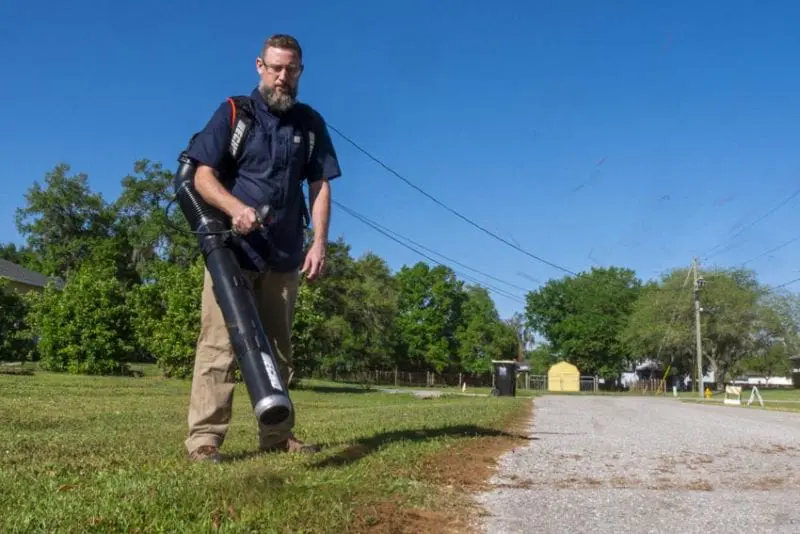
Echo PB-9010T X Series
- Engine: 79.9 cc
- Airspeed: 220 MPH
- Airflow: 1100 CFM
- Blowing force: 48+ Newtons
- ANSI noise rating: 83 decibels
- Dry weight: 26.7 lbs
Despite being released in 2021, the Echo PB-9010T remains the most powerful gas backpack blower on the market today. It even scored higher than the manufacturer’s specs in our force meter test (52 Newtons!). With more than 1100 CFM and 220 mph, this backpack blower tackles wet and stuck material like no other. Where we live in Florida, the frequent summer rains make that absolutely critical.
You also get a large 83.8-ounce fuel capacity, meaning you can work for longer between refueling. It’s comfortable, and the harness allows enough adjustability to accommodate a wide variety of users. Echo also puts the filter above the engine, making it easy to swap out without requiring tools. For professionals, this powerful backpack leaf blower is hard to beat.
Reasons to Buy
- Most powerful backpack blower available
- Excellent dealer support
- Affordable price
- Easy maintenance features
Consider Alternatives if You…
- Don’t need that much power
- Want a more budget-friendly solution
Best Battery Backpack Leaf Blower
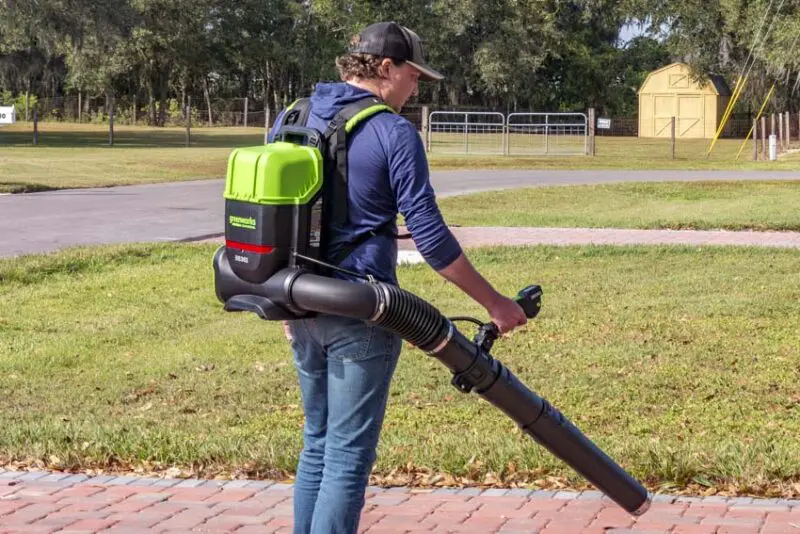
Greenworks Commercial Optimus 82V
- Battery: 2 x 8Ah 82V
- Airspeed: 225 MPH
- Airflow: 755 CFM
- Blowing force: 36+ Newtons
- ANSI noise rating: 65 decibels
- Dry weight: 14.9 lbs
When Greenworks Commercial released the BB361 battery-powered backpack blower with 36 Newtons of output, we saw the bar had been firmly set. Lest you think that’s a “paper” number, it actually measured 36.9 N in our bench testing. Most battery backpack blowers sit around the mid-20s. While top-tier gas models can hit higher numbers, Greenworks Commercial is showing that battery-powered backpack blowers can have performance on par with the most popular gas models professionals use.
Even better, Greenworks includes a pair of 8Ah batteries in the kit, which give you around an hour of runtime when operating the blower at just under 20 Newtons. That makes this a viable option for professional landscapers looking to make the transition to battery.
Reasons to Buy
- Most powerful battery backpack blower
- Low maintenance
- 1 hour of runtime at ~20 Newtons
Consider Alternatives if You…
- Want a more budget-friendly solution
Quietest Leaf Blower
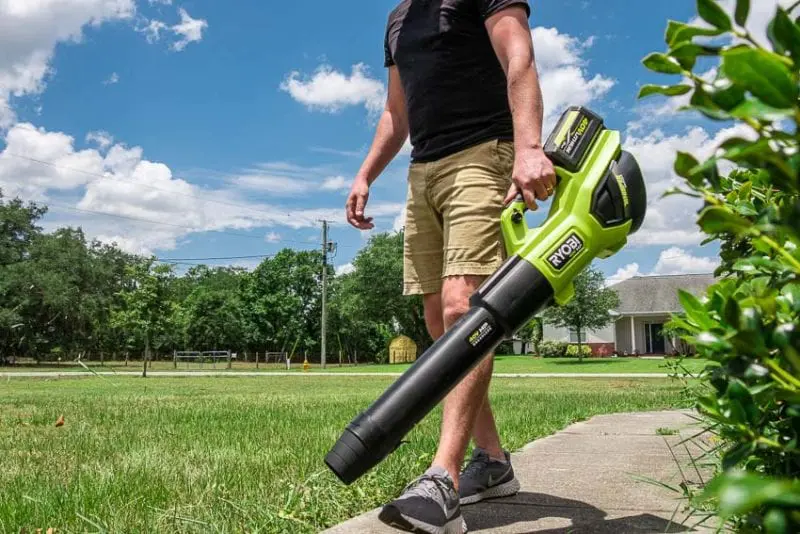
Ryobi 40V HP 730 CFM Whisper Series
- Battery: 2 x 4Ah 40V
- Airspeed: 190 MPH
- Airflow: 730 CFM
- Blowing force: 21.7 Newtons
- ANSI noise rating: 57 decibels
- Dry weight: 6.4 lbs
If low noise and high performance are your top priorities, the Ryobi 40V HP Brushless Whisper Series blower produces up to 730 CFM and 190 MPH. While it’s not quite as strong as the EGO 765 CFM model, we hit 21.7 Newtons in our testing. That crushes the 15-Newton max you see from most handheld gas models.
Adding to its appeal, Ryobi’s design team worked hard to reduce the overall noise level. At full blast (Turbo), we measured just 76 decibels at our operator’s ear and 72 dBA in High. The ANSI rating is just 57 dBA (measured from 50 feet away). Even compared to less-powerful cordless blowers, it’s noticeably quieter.
Reasons to Buy
- Super-quiet performance
- Low maintenance
- Excellent value
Consider Alternatives if You…
- Want the absolute most power possible
- Need more runtime
Best Cordless Handheld Leaf Blower
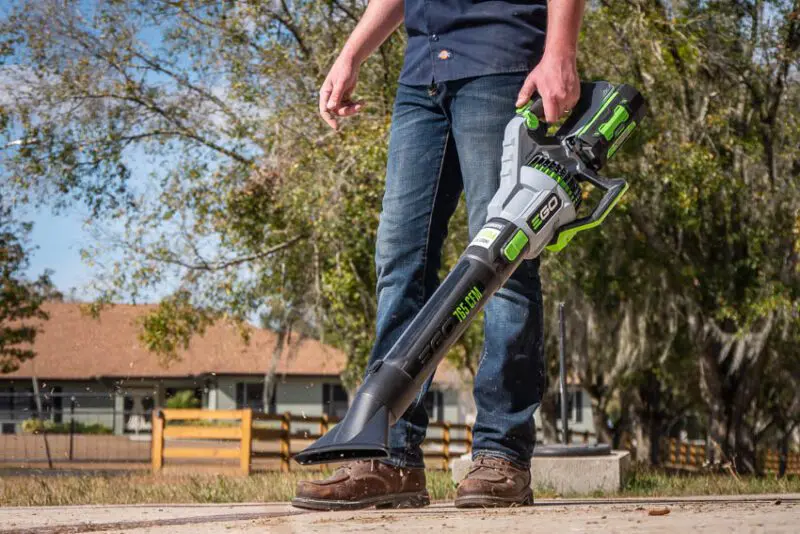
EGO 56V 765 CFM LB7654
- Battery: 4Ah 56V
- Airspeed: 200 MPH
- Airflow: 765 CFM
- Blowing force: 26.1 Newtons
- Noise rating: 76 decibels
- Dry weight: 6.4 lbs
If you’re looking for the most powerful cordless leaf blower, go for EGO’s 765 CFM model. Using a 5.0Ah battery, it hit 25.3 Newton on our meter. Stepping up to a 10.0Ah battery, it hit 26.1 Newtons!
Beyond just raw power, the EGO LB7654 presents an ergonomic working angle that doesn’t fight you when holding it by your side. You get several nozzle options, including a concentrator that increases airspeed at the loss of some CFM. While you may strain your wrist to get the maximum output with a 10Ah battery, you can achieve admirably high blowing force using either a 4Ah, 5Ah, or 6Ah pack.
Reasons to Buy
- Strongest battery-powered blower we’ve tested
- Comfortable working angle
- Concentrator and wide fan nozzles included
- Weather-resistant construction
Consider Alternatives if You…
- Are left-handed
- Want a less expensive option for a smaller yard
Best Corded Electric Leaf Blower

Toro Powerjet F700 Corded
- Power: 120V/12A corded
- Airspeed: 140 MPH
- Airflow: 725 CFM
- Noise rating: 70.1 decibels
- Dry weight: 6.6 lbs
120V AC continues to be a viable power source for some lawn equipment thanks to the low cost of the products you can buy. Of those, the best corded leaf blower is the Toro Powerjet F700. It’s capable of producing 725 CFM with 140 MPH airspeeds. With its 12-amp motor, you don’t have to worry about popping breakers. Plus, it weighs just 6.6 pounds—lighter than many battery-powered leaf blowers before you add the battery. Perhaps best of all, you can get your hands on this model for around $80.
Reasons to Buy
- Strong corded performance with endless runtime
- No gas!
- One of the more powerful corded blowers
Consider Alternatives if You…
- Hate corded inconveniences
- Want to spend a little more for a battery-powered solution
Best Leaf Blower for the Money
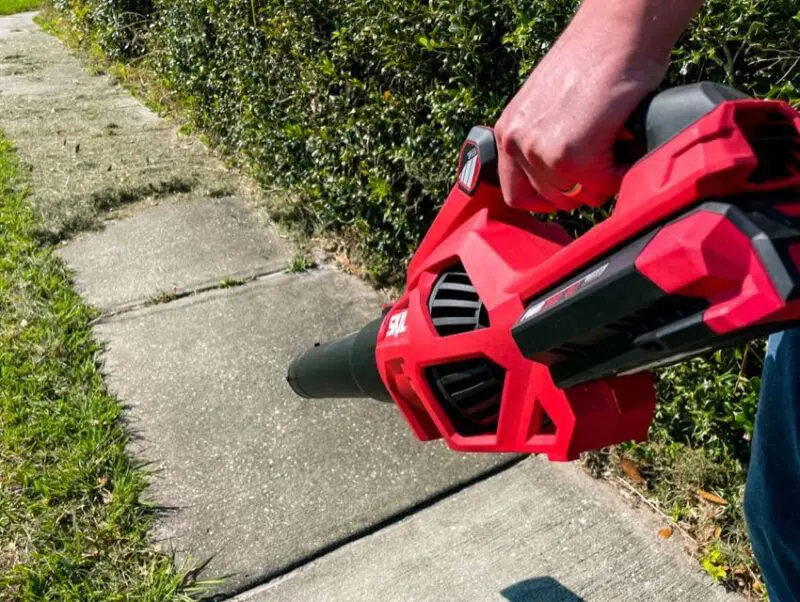
SKIL PWR Core 40 530 CFM Kit
- Battery: 2.5Ah 40V
- Airspeed: 130 MPH
- Airflow: 530 CFM
- Blowing force: 14.1 Newtons
- Noise: 76 dBA (3-ft)
- Dry weight: 4.1 lbs
Any homeowner should love the value proposition of the Skil 40V 530 CFM leaf blower. Its lightweight design (just 6.6 pounds with the 2.5Ah battery) provides excellent ergonomics. It definitely puts out enough power to tackle smaller yards with ease. At 35 inches long, this blower is very easy to maneuver and store when the job is done—particularly since the tube detaches quickly with the push of a button.
This is a well-balanced blower that keeps its nose down naturally, so it works with you, not against you. While you can find more powerful battery-powered blowers, Skil’s price and overall value are nearly impossible to beat.
Reasons to Buy
- Best small yard leaf blower value
- Lightweight
- Easy to store
Consider Alternatives if You…
- Want more power
- Require longer runtime
Our Process and the Nitty Gritty
- Why You Can Trust Pro Tool Reviews
- More Leaf Blowers We Recommend
- What to Look for When Buying a Leaf Blower
- Why Buy a Leaf Blower
- How Much Does a Leaf Blower Cost?
Why You Can Trust Pro Tool Reviews
Since 2008, Pro Tool Reviews has conducted hands-on testing of power tools, hand tools, and accessories and reported on industry news in the construction, automotive, and lawn care industries. Our pro reviewers work in the trades and have the skills and experience to know whether tools can perform well in the field. It’s all about giving you a legitimate recommendation and our honest opinion of each product.
We work with more than two dozen professional contractors around the United States who review products for us on real jobsites and consult with us on testing methods, procedures, and rankings. We’ll provide more than 700 pieces of new content this year absolutely free for our readers—including objective evaluations of individual tools and products.
The end result is information you can trust because of the editorial, scientific, and real-world professional experience we collectively utilize each and every time we pick up and test a tool.
More Options from Brands We Trust
DeWalt DCBL772 60V Leaf Blower
Without a doubt, the DCBL772 is the best handheld DeWalt leaf blower. It uses the 60V Max FlexVolt battery for higher power and runtime. Its 600 CFM and 125 MPH levels combined to hit 17.0 Newtons in our testing. While that beats out handheld gas units, its 91 decibels at the operator’s ear are higher than most of the competition. The pitch is also higher than others, which irritated some of our testers.
It features a straight, inline design with a 5.5-inch angled handle. It weighs 9 pounds with a 60V Max 3.0Ah battery. Additionally, this model has a balanced design thanks to a centrally located battery that inserts from behind the handle. Compared to DeWalt’s previous 60V blower, with its slightly offset rear battery port, the design is an improvement.
- Best For: Cordless mid-range professional and homeowner use
- Max Airflow: 600 CFM
- Max Air Speed: 125 MPH
- Blowing Force: 17.0 Newtons
Echo X Series 25.4cc Handheld Leaf Blower
With Echo’s PB-2620, you get a professional-grade built-in-America gas handheld blower for just $260. Its 25.4cc engine cranks out 456 CFM and 172 MPH, beating out Stihl in overall blowing force with 15.8 Newtons. It may not have as many comfort and ease-of-use features as Stihl, but it’s a hardworking, reliable model you can count on.
- Best For: Professionals who want the highest performance in a handheld blower
- Max Airflow: 456 CFM
- Max Air Speed: 172 MPH
- Blowing Force: 15.8
Greenworks 60V 750 CFM Leaf Blower
All of your Greenworks leaf blower options are cordless, but you still need to decide on the battery system you want to use. The 40V line is great for homeowners with smaller lawns, but the 60V system provides the best balance of performance and price.
On the 60V platform, our favorite Greenworks leaf blower is the BL60L410. Boasting 750 CFM and 170 MPH, this model hit with more than 20 Newtons in our testing, putting it in the elite 20+ Newton class. We also got 30 minutes of runtime on high when using it with a 4Ah battery. That’s very respectable for a blower with this kind of power.
- Best For: High-performance homeowner use
- Max Airflow: 750 CFM
- Max Air Speed: 170 MPH
- Blowing Force: 20+ Newtons
Husqvarna Mark III 580BTS Backpack Blower
Husqvarna meets the needs of Pros and homeowners with leaf blowers that use gas engines or battery power. The problem is that we’re torn between three models as to which one is the best. For the property owner with a lot of space to clear, the 30 Newton 360BT backpack blower is a fantastic choice. Then there’s the class-leading 350iB 40V cordless handheld blower that boasts a monster 800 CFM and hits 23 Newtons.
But it’s the professional-grade Mark III 580BTS backpack blower that comes out on top. With airflow delivery at 1000 CFM and 220 MPH, it’s capable of producing 47 Newtons of blowing force and makes it a worthy competitor against both Stihl and Echo.
- Best For: High-performance professional use
- Max Airflow: 1000 CFM
- Max Air Speed: 220 MPH
- Blowing Force: 47 Newtons
Makita CBU02 Backpack Leaf Blower
Looking toward Makita’s gas-free future, the ConnectX line impresses us with its Pro-focused performance. Attach the 1200Wh ConnectX power supply to the unit, and this backpack blower delivers up to 670 CFM, 160 MPH, and 22 Newtons of blowing force.
- Best For: Cordless high-performance professional use
- Max Airflow: 670 CFM
- Max Air Speed: 160 MPH
- Blowing Force: 22 Newtons
Milwaukee M18 Fuel 2824 Dual-Battery Blower
Milwaukee stepped up its cordless blower game with the release of the M18 Fuel Dual Battery Leaf Blower (model 2824). Using two M18 batteries to increase the overall performance, it’s capable of producing 600 CFM and 145 MPH. The combination registered a stable 18.0 Newtons in our testing, marking a big improvement from Milwaukee’s previous blowers.
- Best For: Cordless mid-range professional use
- Max Airflow: 600 CFM
- Max Air Speed: 145 MPH
- Blowing Force: 18.0 Newtons
Ridgid R01601 Leaf Blower
Ridgid is a newcomer to the lawn care sector and long-time fans of its high-value 18V battery system are welcoming the new tools with open arms. For its first-generation dedicated leaf blower (there have been several jobsite blowers), its 510 CFM/130 MPH performance hit 12.8 Newtons on our meter. While that doesn’t put it in contention with the eye-popping numbers some brands have, it does exceed what you can get from gas homeowner-level handheld blowers and gets Ridgid off to a good start.
- Best For: Homeowner use
- Max Airflow: 510 CFM
- Max Air Speed: 130 MPH
- Blowing Force: 12.8 Newtons
Stihl BR 800 C-E Magnum
Launched back in 2018, Stihl’s BR 800 C-E Magnum is still one of the best backpack blowers, according to testing and crew feedback. While no longer the strongest on the market, it still tops Stihl’s lineup. It blows at up to 239 MPH and has 912 CFM. That all adds up to 41 Newtons when we tested the overall blowing force.
A side-mounted pull start lets you actually don the blower before starting the engine of the BR 800 X Magnum. When it comes to professional-grade gas leaf blowers, it doesn’t get much more convenient.
- Best For: High-performance professional use
- Max Airflow: 912 CFM
- Max Air Speed: 239 MPH
- Blowing Force: 41 Newtons
Best Toro Leaf Blower
Featuring a unique front handle that encourages two-handed use, the Toro 51822 60V Max Leaf Blower is a nice step up from the initial models that came out for the line. Delivering up to 605 CFM and 157 MPH, it’s a solid performer that won’t leave you wishing you’d stuck with gas.
- Best For: Mid-range homeowner use
- Max Airflow: 605 CFM
- Max Air Speed: 157 MPH
- Blowing Force: Not rated
Leaf Blower Buying Guide – What We Look For
Gas, Battery, or Electric?
Choosing a power source is a big part of your blower-buying journey. Here’s a breakdown of the pros and cons of each power source:
Gas Blower Pros
- Low to mid-range cost
- Most powerful backpack and walk-behind models
- Easy to find service and repair shops
Gas Blower Cons
- Loudest and often requires hearing protection
- Produces emissions
- You have to mix gas and oil
- Requires regular maintenance
- Often requires service if it sits for a season
- Some areas restrict or prohibit use
Battery Blower Pros
- Most powerful handheld models
- Quieter operation, typically below 85 decibels at the operator’s ear.
- No direct emissions during use
- No fuel to mix
- Little to no maintenance is required
- Can sit for a long time and start right up with a charged battery
- No restrictions on use
Battery Blower Cons
- More expensive than equivalent gas or corded models
- Batteries take longer to recharge than filling a gas tank
- Difficult to find nearby service/repair centers if needed
Corded Blower Pros
- Quiet operation
- No fuel to mix
- Unlimited runtime
- No direct emissions during use
- Lighter than most gas and cordless models
- Little to no required maintenance
- Most affordable
- Can sit for a long time and start right up
- No restrictions on user
Corded Blower Cons
- Not as powerful as gas or cordless models
- You have to have an AC power source and drag a cord around
- Typically treated as a throw-away item rather than repaired
Noise
Leaf blowers and noise complaints have come to the forefront of OPE conversation recently. In all seriousness, I’m listening to our neighbor’s lawn guy using a backpack blower as I’m writing this. Talk about irony!
Whether you’re for or against gas blowers, there’s no denying they produce significantly more noise than their electric and battery-powered counterparts.
ANSI regulates that you test noise from 50 feet, focusing on bystanders. We test at the operator’s ear. Most cordless and electric models produce less than 90 decibels, and a good chunk of them are under 85 decibels—OSHA’s threshold for hearing protection. On the other hand, gas blowers are typically well over 90 decibels, and powerful backpack or walk-behind models can be over 100 decibels.
The point is that the power source you choose for your blower has a significant effect on how much noise you’re going to produce.
CFM, MPH, and Newton Force
Leaf blower have three forms of performance measurement for you to consider. Almost all brands rate CFM and MPH. More recently, Newtons are becoming a standard measurement, and that’s a good thing.
CFM measures airflow. The higher the measurement, the better you’re able to keep debris that’s in motion moving.

MPH measures airspeed. The higher the value, the heavier an object you can move with your blower.
Both numbers are important because they give you an idea of a blower’s ability to get clutter moving and keep it going. However, Newton force is the most important number when comparing overall blowing force. There’s no easy equation because things such as temperature and humidity affect it. The best way is to measure it with a force meter, which is how we test.
Learn more about the relationship between CFM, MPH, and Newton force here.
Weight, Balance, and Comfort
Weight plays a big role in how fatiguing it is to use a blower. In general, the lighter the better. That said, a well-balanced blower that weighs a little more is better than one that’s off-balance. For handheld blowers, look for models that naturally balance downward 5 – 8 feet in front of you, including a battery or gas and oil.
Comfort is another consideration. For handheld blowers, it’s primarily about the handle design. Look for handles that fit naturally in your hand and avoid any seams that are rough against your skin.
For backpack blowers, it’s all about the harness. Look for models with plenty of padding around your shoulders and hips. You want enough adjustment in the straps to fit everyone on your crew. The hip strap should be substantial enough to move the weight of the blower to your hips without creating pressure points. A chest strap is also useful to keep the shoulder straps from moving much.
The other piece of the comfort puzzle is your back. Look for a harness that has a gap so air can flow and help cool you down. Some models even have active cooling that forces air across your back.
Price and Value
If you’re like us, you have a budget when you’re shopping, and you want the best leaf blower you can get for the money you’re willing to spend. In our opinion, it’s not just about performance. However, your priorities may be different than ours. So take a look at the list below and decide which characteristics are the most important to you as you shop.
- Performance (CFM, MPH, and Newtons)
- Runtime/fuel tank size
- Power source (gas, battery, or electric)
- Weight and balance
- Comfort
- Noise level
- Convenience/ease-of-use
- Maintenance requirements
- Commercial or residential build quality
- Storage space
- Retailer availability
- Serviceability
- Warranty
Why Buy a Leaf Blower?
If you take care of your own property or you run a commercial lawn care/landscaping business, you likely need a leaf blower. They serve two primary functions. In the fall, they help move leaves into a common area to collect. From spring through the fall, they help blow grass clippings off of hard surfaces to give you a nice, clean finish.
There’s a third function that not everyone knows about—snow blowing. In the winter, a leaf blower can easily move soft snowfall off of hard surfaces and vehicles. High-end battery-powered models are particularly effective at this. On the other hand, gas models aren’t as easy to get motivated when it’s freezing outside, so pick your battles.
How Much Does a Leaf Blower Cost?
Leaf blowers vary widely in cost. We recommend corded models for well under $100, while commercial-grade battery-powered models can cost as much as $3000, including batteries and a charger.
If you’re a homeowner, plan to spend $80 – $150 for a good corded blower. If you want to go with a battery-powered option, quality low-powered models start around $130, but you could spend well over $300 for the top performers.
Entry-level gas-powered models start around $100 and can be close to $500 for a backpack blower designed for large properties.
For Pros, it’s understandably a different ballgame with the higher-quality components and construction those models require for the longer hours they have to work. Most professional crews use gas, where handheld models start around $300, and top-end backpack styles can creep up to around $700.
Cordless professional blowers start as low as $300 with a battery and charger. They can, however, run nearly $3000 for a high-end backpack blower with a high-capacity battery.



